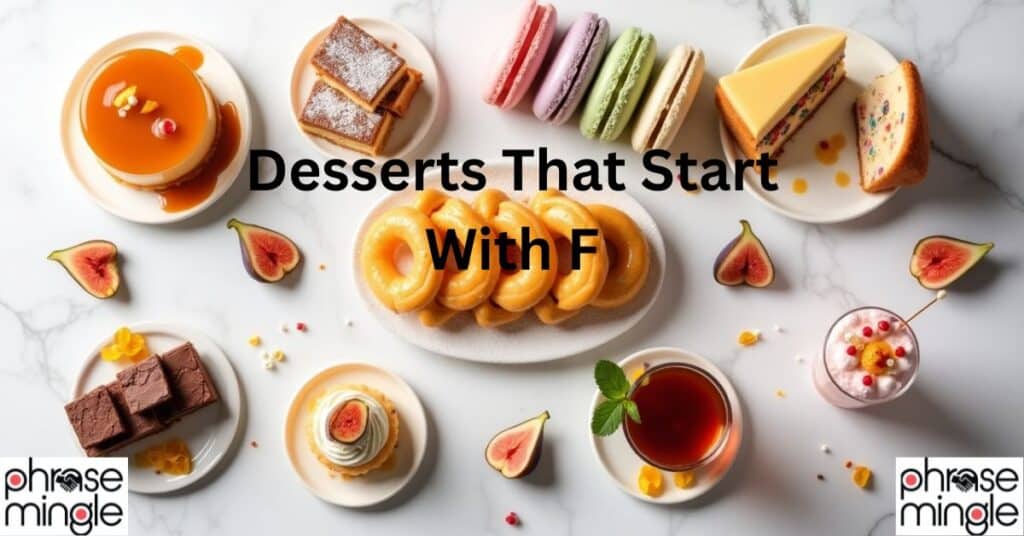Desserts that start with F offer an incredible journey through global confectionery traditions spanning from American carnival classics to European sophistication and international treats. Whether you’re craving comfort food sweets or seeking adventurous flavor combinations this comprehensive collection showcases sixty authentic desserts beginning with the letter F.
From the rich depths of fudge to the delicate layers of French macarons F desserts represent diverse culinary heritage across six continents. You’ll discover time honored recipes passed down through generations alongside modern innovations that push creative boundaries.
This guide delivers authentic dessert knowledge without filler content. Each entry provides cultural context preparation insights and flavor profiles to help you understand what makes these treats special. Ready to explore the fascinating world of F desserts?
Classic American F Desserts
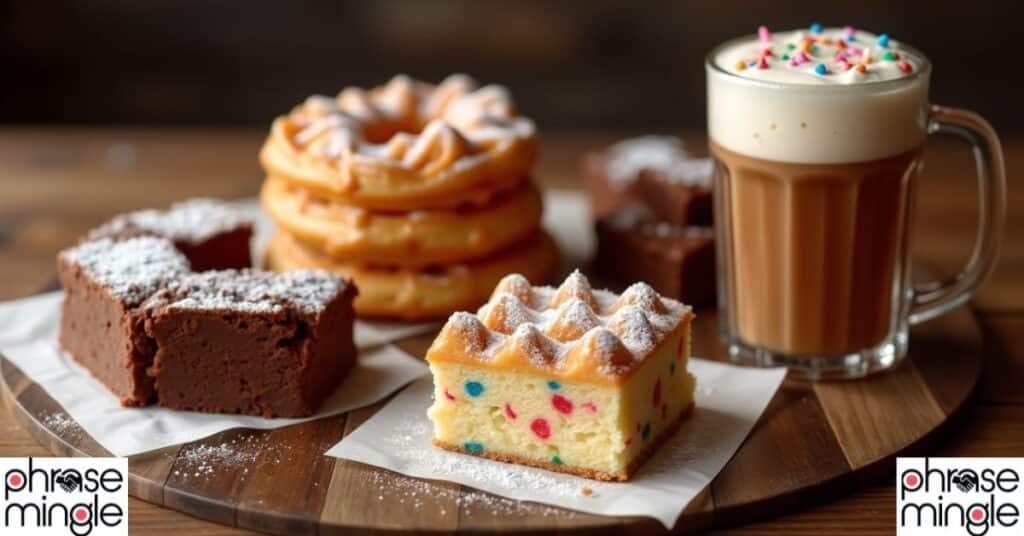
American dessert culture brings bold flavors and generous portions to the F dessert category. These beloved treats reflect regional traditions, carnival atmospheres and home kitchen creativity that defines American sweet making heritage.
1. Funnel Cake
Funnel cake reigns supreme at state fairs and carnivals across America. This iconic treat consists of thin batter poured through a funnel into hot oil, creating crispy golden spirals dusted with powdered sugar.
The dessert originated in medieval Europe but found its American identity in Pennsylvania Dutch communities during the 1600s. Traditional recipes use simple ingredients: flour, eggs, milk and baking powder create the light batter that transforms into crunchy perfection.
Modern funnel cake variations include:
- Chocolate drizzle toppings
- Strawberry compote additions
- Caramel sauce combinations
- Ice cream pairings
Pro tip: Maintain oil temperature at 375°F for optimal crispiness without burning.
2. Fudge
Fudge represents America’s contribution to chocolate confectionery mastery. This dense rich candy originated in the late 1800s when a batch of caramels “fudged” or failed creating something even better.
Traditional chocolate fudge requires precise temperature control. The mixture must reach exactly 234°F (soft ball stage) before cooling and beating to achieve the signature smooth texture. Mackinac Island fudge became legendary with shops producing over 10,000 pounds daily during peak season.
Popular fudge varieties include:
| Type | Key Ingredient | Origin |
|---|---|---|
| Chocolate | Cocoa/Chocolate | American Classic |
| Peanut Butter | Peanut Butter | Southern Favorite |
| Maple | Pure Maple Syrup | Vermont Special |
| Rocky Road | Marshmallows/Nuts | Western Creation |
3. Funfetti Cake
Funfetti cake transformed birthday celebrations when Pillsbury introduced rainbow sprinkle cake mix in 1989. This vanilla sponge cake incorporates colorful jimmies baked directly into the batter creating festive bursts throughout each slice.
The dessert’s appeal lies in its simplicity and joy factor. Unlike traditional birthday cakes requiring elaborate decoration funfetti delivers celebration vibes through integrated sprinkles. The cake pairs beautifully with vanilla buttercream frosting and additional rainbow sprinkles.
Baking science: Coating sprinkles in flour before folding prevents sinking during baking ensuring even distribution throughout the cake.
4. Fried Ice Cream
Fried ice cream creates magical contrasts between hot crispy coating and cold creamy center. This dessert gained popularity at Mexican restaurants but has roots in Asian cuisine particularly Japanese tempura techniques.
The preparation process involves:
- Flash-freezing ice cream scoops until rock-hard
- Coating with crushed cornflakes or cookies
- Quick-frying at 400°F for 30 seconds maximum
- Serving immediately with honey drizzle
Success depends on proper timing and temperature control. The ice cream must remain frozen while the coating achieves golden crispiness.
5. Float
The classic float combines carbonated beverages with ice cream creating effervescent desserts perfect for hot summer days. Root beer floats remain the most popular variety invented in 1893 by Frank J. Wisner in Colorado.
This ice cream soda works through simple chemistry: cold ice cream causes rapid carbon dioxide release from soda creating signature foam. The dessert offers endless customization possibilities with different soda and ice cream combinations.
Popular float combinations:
- Orange soda with vanilla ice cream
- Coca-Cola with chocolate ice cream
- Cream soda with strawberry ice cream
- Sprite with lime sherbet
6. Fluffernutter
Fluffernutter represents New England’s contribution to sweet sandwich culture. This treat combines marshmallow fluff with peanut butter between white bread slices creating nostalgic childhood memories since the 1960s.
Marshmallow fluff was invented in 1917 by Archibald Query in Massachusetts. The fluffernutter sandwich gained official recognition when Massachusetts attempted to make it the state sandwich in 2006.
Nutritional note: One fluffernutter provides approximately 400 calories with significant sugar content making it an occasional treat rather than daily fare.
7. Fudge Brownies
Fudge brownies deliver intense chocolate satisfaction through dense moist texture that distinguishes them from cake like varieties. These treats emerged during the late 1800s when American bakers experimented with chocolate bar additions to existing recipes.
The perfect fudge brownie requires specific ingredient ratios:
- High chocolate content (60% cocoa minimum)
- Butter to flour ratio of 2:1 for optimal density
- Minimal mixing to prevent tough texture
- Underbaking slightly for fudgy consistency
Ghirardelli brownies became the gold standard after Domingo Ghirardelli perfected his recipe in San Francisco during the 1850s.
8. Frozen Custard
Frozen custard elevates ice cream through egg yolk additions and specialized churning techniques. This premium frozen dessert contains at least 1.4% egg yolk solids and 10% milkfat creating silkier texture than regular ice cream.
Wisconsin and New York claim frozen custard origins with Kohr Brothers establishing the first boardwalk stand in 1919. The dessert requires continuous churning while freezing incorporating less air than traditional ice cream.
Temperature serving: Frozen custard serves at 18°F compared to ice cream’s 10°F allowing more pronounced flavor development.
9. Frozen Yogurt
Frozen yogurt emerged as the health conscious alternative to ice cream during the 1970s wellness movement. This dessert contains live active cultures from yogurt fermentation offering potential digestive benefits alongside reduced fat content.
TCBY (The Country’s Best Yogurt) popularized frozen yogurt nationally in 1981. Modern varieties range from tart Greek style to sweet ice cream like consistencies with endless topping combinations.
Probiotic content: Quality frozen yogurt contains 100 million CFU (colony forming units) per gram of beneficial bacteria.
10. Fried Oreos
Fried Oreos represent state fair innovation at its finest. These treats involve dipping Oreo cookies in pancake or funnel cake batter before deep frying until golden creating warm gooey centers with crispy exteriors.
The dessert gained nationwide attention at the 2002 North Carolina State Fair. Charlie Boghosian is credited with the original creation transforming simple cookies into carnival sensations.
Preparation tip: Chill Oreos before battering to prevent complete melting during frying process.
11. Fruit Pizza
Fruit pizza transforms traditional pizza concepts into dessert format using sugar cookie crusts, cream cheese frosting and fresh fruit toppings. This visually stunning dessert became popular at potluck gatherings and summer parties during the 1980s.
The “pizza” requires three components:
- Sugar cookie crust rolled thin and baked until golden
- Cream cheese frosting sweetened with powdered sugar
- Fresh fruit arrangement creating colorful patterns
Assembly timing: Add fruit just before serving to prevent soggy crust from fruit juices.
12. Fortune Cookies
Fortune cookies provide sweet endings to Chinese American restaurant meals though their origins trace to Japanese immigrants in California. Makoto Hagiwara likely created the first versions at Golden Gate Park’s Japanese Tea Garden around 1914.
These crispy cookies contain paper fortunes folded inside while warm. The cookies require precise timing during shaping too hot burns fingers too cool prevents proper folding.
Production facts: American fortune cookie factories produce over 3 billion cookies annually with most fortunes written by just a few companies.
European Desserts that start with F
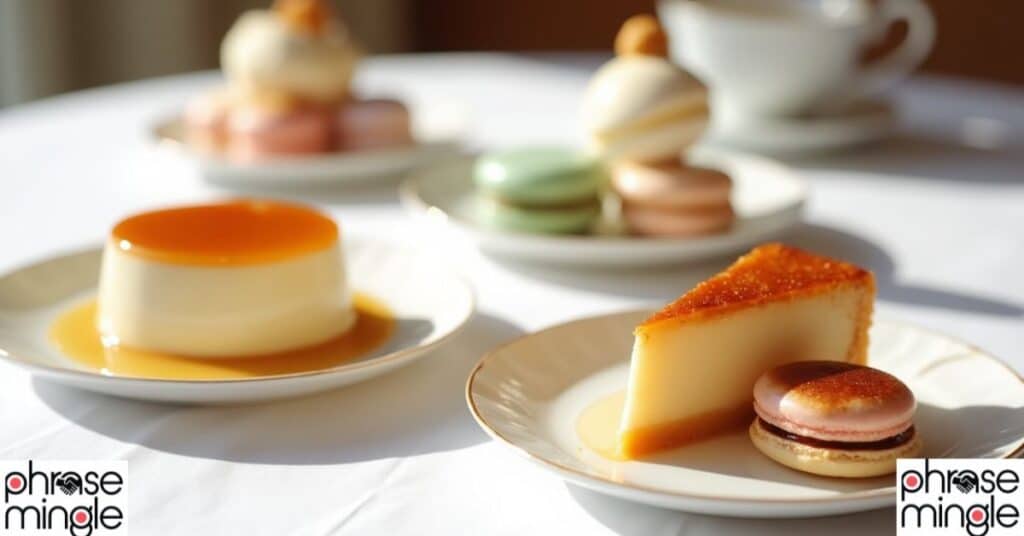
European dessert traditions bring centuries of refinement and regional specialization to F desserts. These sophisticated treats showcase technical mastery, seasonal ingredients and cultural celebrations that define European confectionery excellence.
13. Flan
Flan represents Spanish culinary artistry through silky caramel custard perfection. This dessert combines eggs, milk and sugar with caramelized sugar coating, creating elegant presentations across Spanish speaking cultures.
The technique requires careful caramel preparation without crystallization, followed by gentle custard cooking in water baths (bain marie). Traditional Spanish flan uses whole milk and egg yolks for richness while Latin American versions often incorporate condensed milk.
Temperature precision: Custard sets properly between 325-350°F oven temperature preventing curdling while ensuring smooth texture.
Regional flan variations:
- Flan de huevo (Spain) Pure egg custard
- Flan napolitano (Mexico) Cream cheese addition
- Flan de coco (Caribbean) Coconut milk base
- Flan parisien (France) Vanilla bean infusion
14. Financier
Financier embodies French patisserie precision through delicate almond sponge cake rectangles that resemble gold bars. These petit fours originated in Paris’s financial district during the 1890s designed for busy bankers who needed elegant treats they could eat without utensils.
The recipe requires beurre noisette (brown butter) for nutty complexity, almond flour for moisture and egg whites for lightness. Traditional financiers bake in rectangular molds, though modern versions use various shapes.
Key technique: Brown butter to hazelnut color (165°F) for optimal flavor development without burning.
Financier flavor variations:
- Chocolate Cocoa powder addition
- Lemon Citrus zest incorporation
- Pistachio Ground pistachio substitution
- Seasonal fruit Berry or stone fruit additions
15. Figgy Pudding
Figgy pudding connects modern celebrations to medieval English traditions through this dense, steamed Christmas pudding. Despite its name traditional recipes often contain raisins rather than figs reflecting historical ingredient availability.
The dessert requires months of preparation with ingredients mixed weeks before Christmas to develop flavors. Suet provides traditional fat content, though butter substitutions work for modern palates. Families often hide silver coins inside for luck.
Aging process: Puddings improve flavor when stored in cool dark places for 2-6 months before serving.
Traditional figgy pudding ingredients:
- Dried fruits (raisins, currants, candied peel)
- Breadcrumbs for texture
- Suet or butter for richness
- Eggs for binding
- Brandy for preservation and flavor
16. French Macarons
French macarons represent patisserie artistry through delicate almond cookies sandwiched with ganache, buttercream or jam fillings. These treats originated in Italy but achieved perfection in French hands, particularly at Ladurée in Paris.
Success requires precise measurements, proper macaronage (mixing technique) and environmental control. The cookies develop characteristic “feet” during baking when conditions align perfectly.
Technical requirements:
- Almond flour must be finely ground and sifted
- Aging egg whites for 24-48 hours improves stability
- Macaronage technique requires exactly 35-50 folds
- Resting period allows skin formation before baking
Common macaron flavors:
- Vanilla Classic Madagascar bean
- Chocolate Valrhona cocoa powder
- Raspberry Fresh fruit puree
- Pistachio Ground nut paste
- Rose Floral water essence
17. Far Breton
Far Breton showcases Brittany’s rustic dessert traditions through this custard like tart studded with prunes. The name derives from Breton “far” meaning flour based dish reflecting the region’s agricultural heritage.
This dessert sits between flan and clafoutis with denser texture than typical custards. Traditional recipes use rum soaked prunes though modern versions incorporate various dried fruits or fresh berries.
Regional authenticity: Authentic Far Breton requires prunes other fruit versions are technically “flaugnarde.”
18. Flaugnarde
Flaugnarde comes from France’s Limousin region, similar to Far Breton but typically made with apples, pears or other fresh fruits instead of prunes. This rustic dessert transforms simple ingredients into comforting home style treats.
The batter resembles thick pancake mixture poured over fruit in buttered dishes before baking. Results vary from custard like to cake like depending on egg and flour ratios.
Seasonal adaptations: Spring versions use cherries, summer incorporates berries, autumn features apples or pears.
19. Faworki
Faworki (also called chrusty or angel wings) represent Polish carnival traditions through delicate, twisted pastries dusted with powdered sugar. These treats appear during Tłusty Czwartek (Fat Thursday) before Lent begins.
The dough requires careful handling too much kneading creates tough pastries, while proper technique yields crispy, light results. Traditional recipes include egg yolks and vodka for tenderness.
Cultural significance: Faworki symbolize temporary indulgence before Lenten fasting, making them special occasion treats rather than everyday desserts.
20. Flummery
Flummery represents Welsh comfort food through this oatmeal based pudding that sustained families through harsh winters. The dessert combines oatmeal with milk, sugar and sometimes eggs, creating filling nutritious treats.
Modern versions often include cream or gelatin for smoother textures, though traditional recipes rely on oatmeal’s natural thickening properties. Some recipes incorporate lemon juice for tanginess.
Historical note: Flummery served as both dessert and breakfast food in Welsh households providing essential calories during difficult times.
IF YOU WANT TO READ ABOUT DESSERTS THAT START WITH “U” CLICK HERE
21. French Apple Tart
French apple tart (tarte aux pommes) exemplifies French pastry mastery through precise technique and quality ingredients. This classic dessert features paper thin apple slices arranged over pastry cream in buttery pâte brisée crusts.
Success requires proper apple selection Granny Smith or Golden Delicious varieties hold shape during baking while providing appropriate tartness. The pastry cream base prevents soggy bottoms while adding richness.
Assembly technique: Overlapping apple slices in rose patterns creates professional appearance while ensuring even cooking.
22. Flourless Chocolate Cake
Flourless chocolate cake achieves intense chocolate flavor through minimal ingredients and careful technique. This dessert gained popularity as gluten free dining expanded though it originated as a way to showcase premium chocolate without dilution.
The cake relies on eggs for structure with chocolate and butter providing richness. Quality chocolate (70% cocoa minimum) is essential cheap chocolate produces disappointing results.
Baking method: Water bath (bain marie) baking prevents cracking while ensuring even cooking throughout.
23. French Toast
French toast (pain perdu) transforms stale bread into luxurious breakfast desserts through egg custard soaking and careful cooking. This dish originated as a frugal way to use day old bread earning the name “lost bread” in French.
Perfect French toast requires thick cut bread (brioche challah or Texas toast) adequate soaking time and moderate heat for complete cooking without burning. Overnight soaking creates custard like interiors.
Serving traditions: French versions often serve with fresh fruit and powdered sugar while American styles favor maple syrup and butter.
24. Floating Island
Floating Island (île flottante) showcases French dessert elegance through poached meringue “islands” floating on vanilla custard “seas” topped with caramel threads. This dessert requires multiple techniques but creates stunning presentations.
The meringue requires careful poaching in barely simmering water to maintain shape and texture. Swiss meringue works best for stability while the custard base uses classic crème anglaise techniques.
Caramel decoration: Spun caramel threads require precise temperature (340°F) and quick work before hardening.
25. Forest Cake
Forest Cake (Schwarzwälder Kirschtorte or Black Forest Cake) originates from Germany’s Black Forest region combining chocolate sponge cake with cherries, whipped cream and kirschwasser (cherry brandy). This dessert gained international recognition through German immigrants and fine dining establishments.
Authentic versions require sour cherries and genuine kirschwasser not maraschino cherries and artificial flavoring. The cake layers absorb cherry syrup and brandy, creating complex flavor development.
Traditional assembly: Three layers with cherries and cream between each topped with chocolate shavings and whole cherries.
26. Fatost
Fatost represents Norwegian comfort food through this simple sour cream porridge dessert. This traditional treat combines sour cream with flour and milk, creating rich warming desserts perfect for cold Scandinavian winters.
The dish requires careful cooking to prevent curdling with constant stirring during flour incorporation. Traditional serving includes butter dots, cinnamon sugar and sometimes berry compotes.
Cultural context: Fatost appears at Norwegian celebrations particularly after heavy meals as a lighter dessert option.
27. Fatias De Tomar
Fatias De Tomar showcase Portuguese convent cuisine through these egg custard slices similar to crème caramel but served in rectangular portions. These desserts originated in Tomar’s convents, where nuns created elaborate sweets using abundant egg yolks.
The custard requires gentle cooking in water baths to prevent curdling with caramel syrup providing sweetness and visual appeal. Traditional recipes use only egg yolks creating intense richness.
Historical significance: Portuguese convents developed numerous egg based desserts because local wine industry used egg whites for clarification leaving abundant yolks.
Global F Sweet Treasures
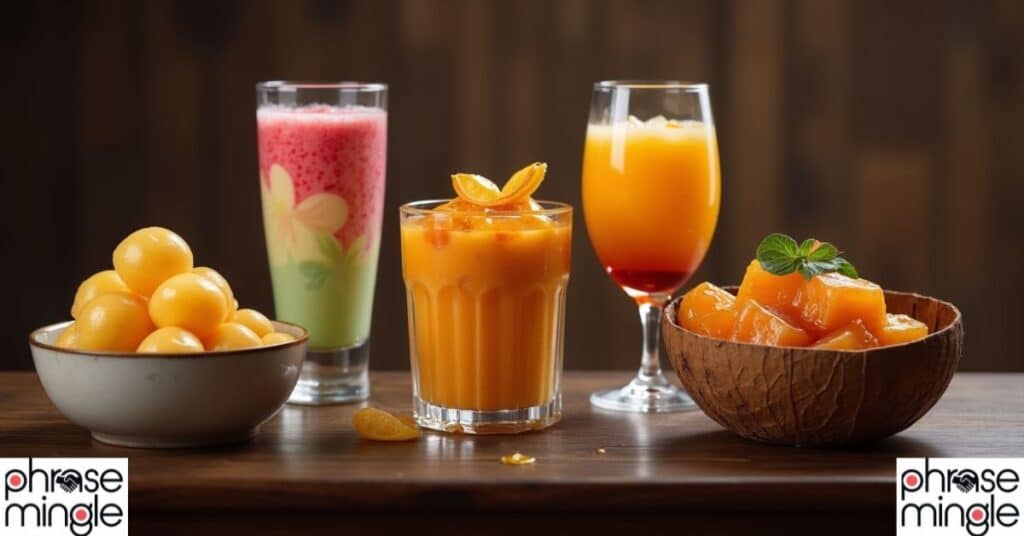
International dessert traditions contribute flavors, unique techniques and cultural celebrations to the F dessert collection. These treats showcase ingredient creativity and preparation methods that expand dessert horizons beyond Western traditions.
28. Falooda
Falooda represents Indian subcontinent dessert beverages through layered combinations of rose syrup, vermicelli noodles, basil seeds and ice cream or kulfi. This refreshing treat originated in Persia but found its identity in Indian street food culture.
Traditional falooda includes multiple textures and temperatures creating complex sensory experiences. Basil seeds (sabja) provide gel like coating when soaked while thin vermicelli adds substance.
Assembly order: Rose syrup base soaked noodles and seeds, milk, ice cream topping with nuts garnish.
Regional falooda variations:
- Bombay style Extra thick consistency
- Kulfi falooda Traditional ice cream topping
- Dry fruit Abundant nut additions
- Fruit Fresh fruit pieces
29. Fazuelos
Fazuelos connect Sephardic Jewish communities to Spanish heritage through these honey soaked fritters served during Hanukkah. The dessert reflects Mediterranean Jewish cuisine, maintaining traditions despite geographic dispersion.
The dough requires careful handling too much flour creates heavy fritters, while proper technique yields light, airy results. Orange blossom water in the honey syrup provides traditional aromatic complexity.
Cultural significance: Fazuelos represent one of the few Sephardic desserts maintaining unchanged recipes across centuries and continents.
30. Fakthong Kaeng Buat
Fakthong Kaeng Buat showcases Thai dessert mastery through this pumpkin coconut custard that balances sweet, creamy and aromatic elements. This dessert uses kabocha pumpkin steamed until tender, then filled with coconut custard.
The custard requires precise coconut milk ratios too thin won’t set properly too thick becomes rubbery. Palm sugar provides authentic sweetness with caramel undertones impossible to replicate with white sugar.
Preparation method: Hollow pumpkin pieces steam with custard inside creating natural serving vessels.
31. Fa Gao
Fa Gao represents Chinese New Year traditions through these steamed sponge cakes that “bloom” during cooking, symbolizing prosperity and growth. The name literally means “prosperity cake” in Mandarin.
Success requires proper steaming technique steady steam without water droplets falling on cakes. Active dry yeast or baking powder creates the characteristic “blooming” effect that determines fortune predictions.
Symbolic meaning: Cakes that bloom widely predict good fortune, while flat cakes suggest challenges ahead.
32. Feneketlen Turotorta
Feneketlen Turotorta (Hungarian “bottomless cheesecake“) eliminates traditional crust in favor of pure cottage cheese filling. This dessert represents Hungarian home cooking through simple ingredients transformed into elegant results.
The recipe requires farmer’s cheese or cottage cheese, creating lighter texture than American style cheesecake. Lemon zest and vanilla provide essential flavor balance without overwhelming cheese taste.
Technique: Gentle folding of egg whites maintains airy texture while preventing dense results.
33. Fig Bars
Fig bars honor Mediterranean agriculture through these filled cookies that showcase fresh or dried fig preparations. While Fig Newtons represent commercial versions, traditional fig bars reflect regional baking techniques across fig growing regions.
Homemade versions allow control over fig quality and sugar content. Fresh figs create different textures than dried versions, with seasonal availability determining preparation methods.
Nutritional benefits: Figs provide fiber, potassium and antioxidants, making these treats relatively nutritious among cookie options.
34. Figgy Duff
Figgy Duff represents Newfoundland maritime traditions through this steamed pudding that sustained fishing families during long voyages. The dessert combines dried fruits with suet and flour, creating dense filling treats.
Traditional preparation involves pudding cloths for steaming, though modern versions use bowls or molds. Hard sauce (butter, sugar and rum) provides traditional accompaniment.
Maritime heritage: Sailors valued figgy duff because ingredients kept well at sea and provided essential calories during demanding physical work.
35. Fool
Fool showcases English simplicity through fruit and cream combinations that highlight ingredient quality over complex techniques. This dessert traditionally uses gooseberries, though strawberries, raspberries and other fruits work beautifully.
The preparation requires gentle folding to maintain distinct fruit and cream layers rather than complete mixing. Heavy cream whipped to soft peaks provides proper texture without becoming grainy.
Historical note: “Fool” likely derives from French “fouler” (to crush), referring to fruit preparation method.
36. Fruit Sorbet
Fruit sorbet provides palate cleansing desserts across multiple cultures, using pure fruit flavors without dairy interference. These frozen treats require careful balance between sweetness, acidity and texture.
Success depends on proper sugar ratios too little creates icy textures, too much prevents proper freezing. Simple syrup incorporation ensures smooth results, while lemon juice brightens flavors.
Serving temperature: Sorbets serve best at 5-10°F, allowing flavor development while maintaining scoopable consistency.
37. Fruit Salad
Fruit salad transcends cultural boundaries through fresh fruit combinations that celebrate seasonal availability and natural sweetness. Preparations vary from simple mixed fruits to elaborate presentations with syrups and garnishes.
Quality fruit salad requires careful fruit selection uniform ripeness, complementary flavors and proper cutting techniques prevent mushiness. Citrus juice prevents oxidation while adding brightness.
International variations:
- Rujak (Indonesia) Spicy fruit salad with chili
- Fruit chat (India) Seasoned with spices
- Ensalada de frutas (Mexico) Chili-lime seasoning
- Salade de fruits (France) Light syrup dressing
38. Fruit Soup
Fruit soup represents Scandinavian summer traditions through chilled soups that showcase berry abundance during short growing seasons. These desserts bridge soup and dessert categories through unique presentations.
Nordic fruit soups typically combine multiple berries with light sugar syrups, sometimes thickened with cornstarch or potato starch. Sour cream garnish provides richness and temperature contrast.
Seasonal timing: Peak berry season (July-August) produces optimal flavor intensity for traditional preparations.
39. Fruit Tart
Fruit tart demonstrates French patisserie techniques through precise pastry cream and fresh fruit arrangements over buttery pâte sucrée crusts. These desserts require multiple components executed perfectly for professional results.
The pastry cream must be smooth and properly thickened to support fruit weight without becoming runny. Apricot glaze preserves fruit appearance while adding glossy finish.
Assembly principles: Arrange fruits by color and size for visual impact while considering structural stability.
40. Fruit Whip
Fruit whip creates light, airy desserts through fruit puree incorporation into whipped cream or egg white bases. These treats provide intense fruit flavors with mousse like textures.
Gelatin often stabilizes fruit whips, preventing separation while maintaining smooth consistency. Fresh fruit purees work better than canned versions for authentic flavor development.
Technique: Gradual fruit puree folding prevents deflating while ensuring complete incorporation.
IF YOU WANT TO READ ABOUT DESSERTS THAT START WITH “X” CLICK HERE
41. Fried Banana Ice Cream
Fried banana ice cream combines Southeast Asian street food creativity with Western dessert concepts. This treat features battered, fried bananas served with ice cream, creating temperature and texture contrasts.
Tempura batter creates light, crispy coatings that don’t overpower banana sweetness. Coconut ice cream provides authentic pairing though vanilla works well too.
Oil temperature: 350°F creates proper cooking without banana mushiness or batter greasiness.
42. Fried Pies
Fried pies represent Southern American traditions through hand held pastries filled with fruit preserves or custards, then fried until golden. These treats originated from British hand pies but developed distinct American characteristics.
Traditional fillings include apple, peach, sweet potato and chocolate preparations. The pastry requires proper fat content for flakiness while maintaining structural integrity during frying.
Regional variations: Louisiana uses different spice blends, while Appalachian versions favor local fruit varieties.
43. Fried Sweet Potato Pies
Fried sweet potato pies showcase soul food traditions through individual pastries filled with spiced sweet potato custard, then fried for crispy exteriors. These desserts represent African American culinary creativity and resourcefulness.
The filling requires properly cooked sweet potatoes mashed smooth with traditional spices (cinnamon, nutmeg, allspice) and eggs for binding. Cornmeal addition to pastry provides authentic texture.
Cultural significance: These pies represent celebration foods served at church gatherings and family reunions throughout the American South.
44. Funny Cake
Funny Cake originates from Pennsylvania Dutch communities through this unique dessert featuring vanilla cake batter poured over chocolate syrup in pie crusts. During baking, components separate into distinct layers.
The “funny” aspect comes from unusual preparation liquid chocolate settles to bottom while cake batter rises creating natural layering without manual assembly.
Traditional serving: Room temperature with fresh whipped cream allowing flavors to meld without masking delicate textures.
45. Fairy Bread
Fairy Bread represents Australian childhood through simple white bread spread with butter and covered in colorful sprinkles (called “hundreds and thousands” in Australia). This treat appears at virtually every Australian children’s party.
The simplicity is intentional fresh white bread, real butter and quality sprinkles create nostalgic experiences that resist improvement attempts. Modern variations use different bread types or spreads but lose authentic character.
Cultural importance: Fairy bread serves as generational bonding food with adults fondly remembering childhood parties while creating similar memories for their children.
Specialty F Desserts & Variations
Specialty F desserts showcase regional innovations, seasonal celebrations and creative combinations that push traditional boundaries. These unique treats often represent fusion cuisine or modern interpretations of classic techniques.
46. Fudge Bottom Pie
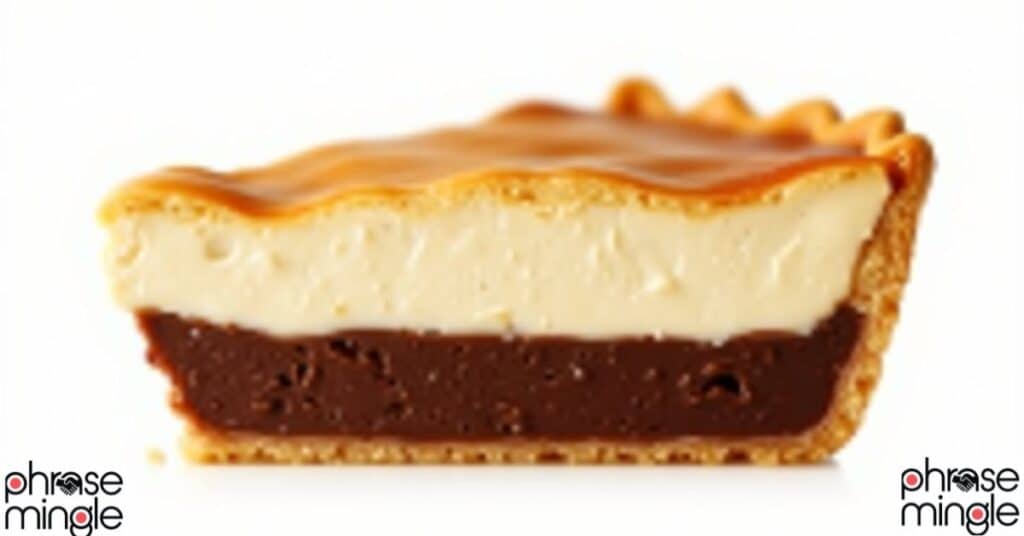
Fudge bottom pie combines multiple dessert elements through rich chocolate fudge layers topped with lighter fillings like vanilla custard or coconut cream. This dessert originated in American diners seeking impressive presentations with manageable preparation.
The fudge layer requires proper consistency firm enough to support upper layers without being too hard to cut cleanly. Cornstarch helps achieve proper texture without grittiness.
Assembly order: Chocolate fudge base, cooling period, cream filling, final cooling then service.
47. Fudge Pie
Fudge pie delivers pure chocolate indulgence through dense, brownie like fillings in pastry crusts. This Southern American dessert bridges pie and candy categories through intense sweetness and rich textures.
Quality chocolate is essential unsweetened chocolate combined with butter and sugar creates proper flavor balance. Corn syrup additions provide smooth texture without crystallization.
Serving suggestions: Small slices with vanilla ice cream or fresh whipped cream to balance richness.
48. Frozen Margarita Pie
Frozen margarita pie transforms cocktail flavors into dessert format through lime tequila filling in graham cracker crusts. This modern creation reflects 1970s-80s trends toward frozen cocktail desserts.
The filling requires cream cheese base for stability, with lime juice and tequila providing authentic margarita flavors. Triple sec additions enhance orange notes without overwhelming lime character.
Alcohol considerations: Proper alcohol ratios ensure flavor without preventing proper freezing.
49. Flapper Pie
Flapper Pie represents Canadian prairie traditions through graham cracker crusts filled with vanilla custard and topped with meringue. This dessert gained popularity during the 1920s Jazz Age, hence the “flapper” name.
The custard requires careful cooking to prevent curdling, while Swiss meringue provides stable topping that won’t weep. Graham cracker crumbs mixed into meringue create textural interest.
Regional pride: Manitoba claims flapper pie as their unofficial provincial dessert, with multiple restaurants featuring signature versions.
50. Flag Pie
Flag pie celebrates American patriotism through red, white and blue fruit arrangements over cream cheese or custard bases. These desserts appear prominently during Fourth of July celebrations and Memorial Day gatherings.
Strawberries and blueberries provide natural flag colors, arranged in stripe and star patterns. Whipped cream or vanilla custard creates white background for fruit placement.
Seasonal timing: Peak berry season coincides perfectly with summer patriotic holidays.
51. Friendship Cake
Friendship cake reflects Amish community values through starter based cakes shared between households. This dessert requires sourdough like starter maintained and passed among friends, creating ongoing baking relationships.
The starter ferments over 10 days with daily additions of flour, sugar and milk. Final cake preparation combines starter with additional ingredients for moist, flavorful results.
Community aspect: Sharing starter creates ongoing obligations and connections between households, reinforcing community bonds.
52. Fruitcake
Fruitcake endures despite jokes through proper preparation that creates moist, flavorful holiday treats. Quality fruitcake requires premium dried fruits, nuts, and spirits for preservation and flavor development.
Aging process improves fruitcake weekly brandy or rum applications over months create complex flavors impossible to achieve immediately. Cheesecloth wrapping prevents drying while allowing alcohol absorption.
International versions:
- Stollen (Germany) Powdered sugar coating
- Panettone (Italy) Light, airy texture
- Christmas cake (Britain) Heavy fruit concentration
- Rum cake (Caribbean) Rum-soaked preparation
53. French Chocolate Cake
French chocolate cake (gâteau au chocolat) emphasizes chocolate purity through minimal ingredients and careful technique. This dessert differs from American chocolate cakes through less sugar and more chocolate intensity.
European chocolate (70% cocoa minimum) provides authentic flavor profiles impossible with sweeter American chocolates. Butter integration requires careful temperature control for proper emulsification.
Serving style: Small portions with crème anglaise or fresh berries, allowing chocolate to dominate flavor profiles.
54. Fruit Soup Variations
Fruit soup variations span global cultures, from Scandinavian berry soups to Hungarian fruit goulash, each reflecting regional ingredients and cooking traditions. These desserts challenge conventional soup dessert boundaries through innovative preparations.
Polish żurek owocowy combines multiple fruits with light cream, while German rote grütze features thickened berry mixtures. Hungarian gyümölcsleves incorporates wine and spices for complex flavor development.
Preparation techniques:
- Cold soups No cooking, fresh fruit emphasis
- Warm soups Gentle heating, spice integration
- Thickened soups Cornstarch or tapioca additions
- Wine based soups Alcohol cooking for depth
55. Frozen Custard Variations
Frozen custard variations across America showcase regional preferences and local ingredients. Wisconsin custard features dense, rich consistency, while New York styles incorporate unique flavor combinations.
Abbott’s Frozen Custard in Rochester pioneered flavor innovation since 1926, introducing daily specials that build customer loyalty. Ted Drewes in St. Louis creates “concrete” consistency so thick spoons stand upright.
Regional specialties:
- Butter brickle Midwest favorite
- Turtle Caramel, chocolate, pecan combination
- Black raspberry Northeast seasonal special
- Key lime Southern variation
56. Fudge Variations
Fudge variations demonstrate American candy creativity through endless flavor combinations and texture modifications. Modern fudge makers experiment with sea salt, bacon, chili peppers, and chocolates.
Michigan fudge maintains traditional standards, while Colorado versions incorporate local ingredients like pine nuts and honey. Vermont maple fudge showcases pure maple syrup without artificial flavoring.
Texture categories:
- Smooth fudge Traditional creamy consistency
- Chunky fudge Nut or candy additions
- Layered fudge Multiple flavor combinations
- Swirled fudge Marbled appearance patterns
Success factors: Temperature control remains crucial 234°F soft-ball stage creates proper texture, while overcooking produces grainy results.
57. Fig Desserts
Fig desserts celebrate Mediterranean abundance through fresh and dried fruit preparations that highlight natural sweetness. Mission figs, Brown Turkey, and Calimyrna varieties each contribute distinct flavors and textures.
Fresh fig preparations require gentle handling due to delicate skin and soft flesh. Dried fig desserts concentrate flavors while providing longer storage capabilities.
Preparation methods:
- Roasted figs with honey and herbs
- Fig compotes for sauce applications
- Fig tarts showcasing visual appeal
- Fig ice cream balancing sweetness
Nutritional benefits: Figs provide fiber, potassium, calcium, and antioxidants, making them healthier dessert options compared to refined sugar treats.
58. Frozen Treats
Frozen treats encompass global cooling desserts from Italian granita to Mexican paletas, each reflecting local ingredients and climate needs. These desserts provide relief during hot weather while showcasing creativity.
Granita requires specific ice crystal formation through careful scraping during freezing. Paletas use fresh fruit purees frozen in molds for natural popsicle alternatives.
International frozen treats:
- Kulfi (India) Dense, rich ice cream
- Gelato (Italy) Slow churned smoothness
- Sorbet (France) Pure fruit intensity
- Shaved ice (Hawaii) Flavored syrup toppings
59. Fried Dessert Collection
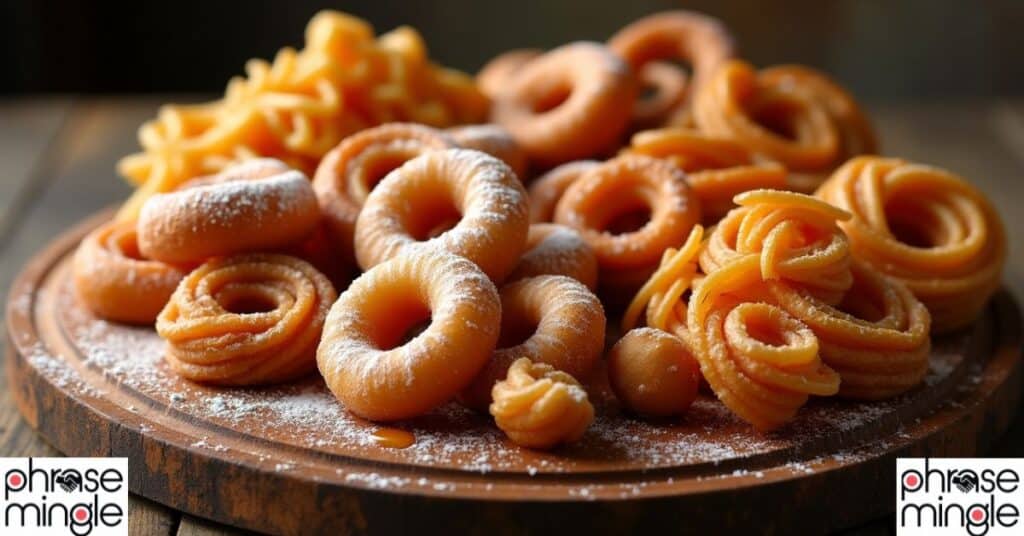
Fried dessert collections showcase global deep frying techniques applied to sweet preparations. From Spanish churros to Italian zeppole, these treats demonstrate how frying creates unique textures impossible through other cooking methods.
Temperature control remains critical across all fried desserts 350°F typically provides optimal cooking without burning. Oil selection affects flavor neutral oils like canola allow dessert flavors to dominate.
Global fried desserts:
- Churros (Spain) Ridged pastry with cinnamon sugar
- Beignets (France/Louisiana) Square pastries with powdered sugar
- Jalebi (India) Spiral-shaped, syrup-soaked
- Loukoumades (Greece) Honey-drizzled puffs
60. Fusion F Desserts
Fusion F desserts represent modern culinary creativity through unexpected ingredient combinations and technique mixing. Contemporary chefs blend traditional preparations with innovative elements, creating entirely new dessert categories.
Matcha fudge combines Japanese tea culture with American candy traditions. Miso caramel flan incorporates umami elements into classic custards. Fried ice cream tacos merge Mexican and Asian street food concepts.
Modern fusion examples:
- French toast bread pudding Multiple comfort food combinations
- Funnel cake ice cream sandwiches Carnival meets ice cream parlor
- Fig and goat cheese financiers Sweet-savory balance
- Frozen yogurt bark Health-conscious candy alternative
Innovation drivers: Social media pressure for Instagram-worthy presentations encourages creative combinations that photograph well while maintaining flavor integrity.
IF YOU WANT TO READ ABOUT DESSERTS THAT START WITH “R” CLICK HERE
Conclusion
This comprehensive exploration of 60 desserts that start with F reveals the incredible diversity within a single letter category. From carnival funnel cakes to elegant French macarons, these treats represent centuries of culinary evolution across six continents.
Regional specialties like figgy pudding connect us to historical traditions, while modern innovations such as fusion F desserts demonstrate ongoing creativity. Whether you’re drawn to comfort foods like fudge brownies or treats like falooda, the F dessert category offers adventures for every palate.
Cultural significance emerges throughout these desserts friendship cake builds community bonds, fairy bread creates childhood memories and figgy duff sustained maritime workers. These treats carry stories beyond their ingredients.
Technical mastery varies from simple fruit salads requiring only knife skills to complex financiers demanding precise technique. This range ensures everyone can participate in F dessert creation, regardless of skill level.
Seasonal availability influences many F desserts, from summer fruit soups celebrating berry harvests to winter fruitcakes preserving abundance through cold months. Understanding these rhythms enhances appreciation for traditional preparations.
The journey through F desserts demonstrates how simple letter categorization reveals vast culinary landscapes. Desserts that start with F showcase human creativity, cultural exchange and the universal desire for sweetness that transcends geographical boundaries.
Ready to expand your dessert repertoire? Start with familiar favorites like fudge or French toast, then gradually explore international treasures like fazuelos or far breton. Each new F dessert mastered opens doors to understanding different cultures through their sweetest expressions.
Share your F dessert discoveries with friends and family these treats taste better when enjoyed together, continuing traditions that span generations and continents.

Jamze Hope,
I am a writer at Phrase Mingle, where i shares insightful phrase guides to help readers enhance their language skills. With a passion for words and clear communication, Jamze creates engaging content that simplifies complex expressions, making them accessible to all.

